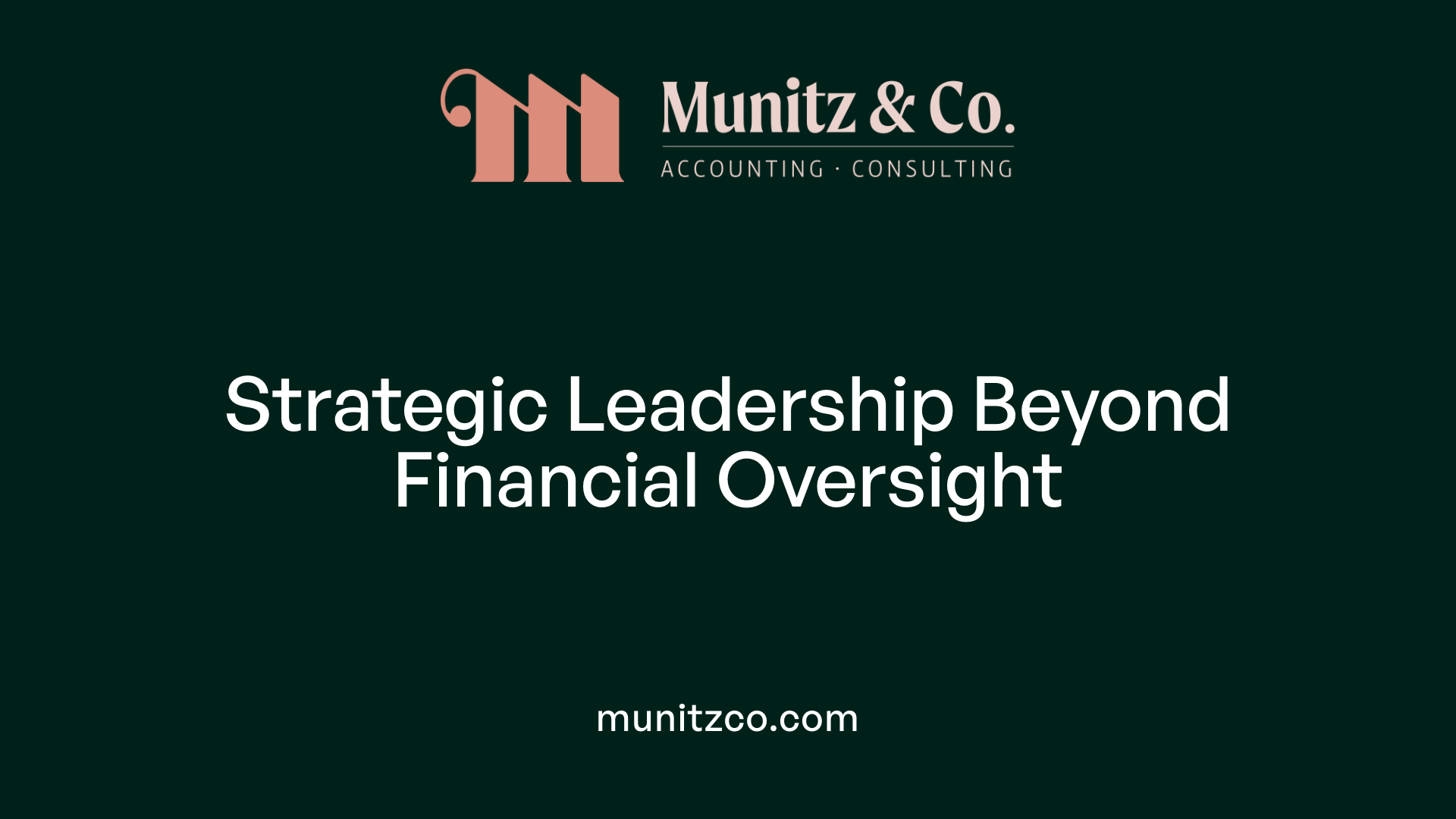Why CFO-Level Insights Matter in Today’s Business Landscape
Navigating the financial complexities of a growing business requires more than just basic accounting—it demands strategic financial leadership. CFO-level insights empower business owners to make informed decisions that drive sustainable growth, enhance enterprise value, and anticipate challenges before they arise. This article explores the critical CFO knowledge that every business owner should understand to elevate their company’s financial health and long-term success.
The Evolving Role of the Modern CFO

What Are the Various Types of CFO Services and Their Core Responsibilities?
CFO services come in several forms to meet different business needs and growth stages. These include fractional CFOs, who work part-time with companies; outsourced CFOs, offering expertise without full-time hires; interim CFOs, filling temporary leadership gaps; and virtual CFOs, providing remote financial leadership. Regardless of the type, CFOs share essential responsibilities such as financial planning, risk management, ensuring compliance, and maintaining clear communication with stakeholders. These roles collectively support sustainable business growth by managing complex financial operations and strategic business needs.
What Is Expected from a Modern CFO Beyond Traditional Financial Oversight?
Today's CFOs surpass traditional financial stewardship by actively participating in strategic decision-making. They frequently attend cross-departmental planning meetings to align finance with sales and operations. Utilizing forecasting, budgeting, and strategic financial modeling, modern CFOs connect daily operational choices with the company's long-term vision. They bring real-time data and scenario analysis into focus, improving financial clarity and supporting proactive cost management, strategic forecasting, and investor confidence. This active collaboration and forward-looking approach make the CFO a critical partner in guiding the company’s growth trajectory.
Why Small and Mid-Sized Businesses Need CFO Expertise

Are CFO services only necessary for large companies?
There is a common misconception that CFO services are only designed for large corporations. In reality, CFO expertise is critical for small and mid-sized businesses (SMBs), especially when accessed through outsourced or virtual CFO services. These models provide companies with seasoned financial leadership and strategic insights without the high cost or commitment of a full-time, onsite CFO.
Benefits of outsourced CFO services for SMBs and startups
Outsourced CFO services offer SMBs and startups the advantage of professional finance management tailored to their growth stage. This includes expert advice on cash flow management, profitability, risk assessment, and long-term financial planning. By leveraging technology and experienced professionals, businesses gain reliable financial data, forecasting, and strategic financial models that enhance decision-making and enterprise value.
Sector focus on SaaS, tech-enabled, and recurring revenue companies
Driven Insights targets sectors like SaaS, tech-enabled businesses, growth SMBs, and recurring revenue models. These companies benefit significantly from specialized CFO services due to the complexity of their financial operations and the importance of strategic alignment between finance and operational goals.
Examples of scenarios warranting CFO engagement such as early funding, scaling, M&A preparation, and cash flow issues
CFO engagement is especially crucial during critical growth moments. Typical scenarios include managing early-stage funding rounds, navigating scaling challenges, preparing for mergers and acquisitions, or addressing cash flow difficulties. In these stages, CFO services provide the clarity and strategic foresight necessary for sustainable growth and informed decision-making.
This strategic financial leadership ensures that SMBs are not only managing their current finances effectively but are also positioned to capitalize on future opportunities.
Building a Growth-Driven Financial Strategy

How do CFOs contribute to building growth-driven financial strategies?
CFOs play a pivotal role in crafting financial strategies that support business growth at every stage. By designing scalable finance approaches, CFOs ensure that financial plans evolve alongside company goals. They utilize sophisticated forecasting, budgeting, and scenario analysis to project cash flow, assess risks, and align operational decisions with long-term vision.
Developing scalable finance strategies aligned with business goals
A core part of a CFO’s work involves creating finance strategies that are adaptable and scalable. This means that as a company grows—from start-up through maturity—its financial processes and plans need to adjust seamlessly. Tailoring these strategies to match each growth phase allows businesses to optimize cash management, profitability, and capital structure.
Leveraging technology for efficient financial systems
Modern CFOs rely heavily on technology to build efficient financial systems. Automation tools, real-time reporting, and integrated software platforms reduce errors and improve data accessibility. This tech-driven approach enhances accuracy, streamlines workflows, and provides timely insights that facilitate quicker decision-making.
The role of forecasting, budgeting, and scenario analysis in strategic planning
Forecasting and budgeting are fundamental tools that enable companies to prepare for multiple future scenarios. CFOs use these tools to create financial models that anticipate market changes and operational challenges. Scenario analysis helps executives explore how different outcomes—like changes in revenue or expenses—impact the company, guiding smarter strategic planning.
Integrating operational decisions with long-term financial vision
Connecting day-to-day operations with overarching financial goals is vital for sustainable growth. CFOs ensure that spending, investment, and resource allocation align with strategic priorities. Through continuous monitoring and transparent communication, CFOs improve financial clarity, enabling leadership teams to make informed decisions that benefit both current performance and future stability.
Enhancing Financial Clarity and Transparency

Importance of Accurate Financials and Reliable Data
Accurate financial statements and dependable data form the backbone of any sound financial strategy. CFO services prioritize these elements to ensure businesses operate based on trustworthy information, reducing risks and enabling proactive management.
Real-Time Insights Supporting Cost Management and Investor Confidence
Modern CFOs leverage technology to deliver transparent, real-time insights. This immediate access to financial data aids in efficient cost control and allows businesses to respond swiftly to changes. Additionally, such transparency fosters investor confidence by demonstrating strong governance and financial stewardship.
Use of KPIs and Reporting
Key performance indicators (KPIs) like profitability, cash flow, budget versus actuals, and customer acquisition costs are meticulously tracked and reported by CFO teams. These metrics provide a clear view of company health and operational effectiveness, underpinning strategic decisions and resource allocations.
Proactive Financial Guidance and Tax Planning
Beyond reporting, CFOs offer forward-looking financial guidance, including year-round tax planning and risk assessment. This proactive approach anticipates challenges and identifies opportunities, enhancing sustainability and long-term growth.
How CFO Services Improve Financial Transparency and Decision-Making
CFO services improve financial transparency by providing comprehensive and timely financial information. This empowers management to manage costs wisely, forecast strategically, and assures investors through consistent KPI monitoring. By connecting operational data with strategic goals, CFOs enable better-informed decisions that drive business success.
Streamlining CFO Onboarding for Maximum Impact

What does a new CFO do during the onboarding process?
A new CFO begins the onboarding journey by conducting a thorough review of the company's recent financial documentation. This includes balance sheets, income statements, cash flow reports, budgets, and forecasts. Understanding these documents lays the foundation for informed decision-making.
Next, the CFO holds initial meetings with key stakeholders such as the CEO, department heads, finance staff, and external advisors. These discussions gather vital operational insights, aligning finance strategies with company goals.
Assessing current financial systems and workflows is a critical step. The CFO evaluates the effectiveness of existing processes and the internal finance team’s structure, identifying inefficiencies that may hamper growth.
Immediate improvements, or "quick wins," help build momentum. These often involve cleaning the general ledger to ensure accuracy, enhancing cash flow reporting for clarity, and streamlining invoice and billing procedures to improve cash management and operational efficiency.
By systematically addressing these areas, the new CFO sets the stage for strategic financial leadership, supporting sustainable business growth from day one.
Customizing CFO Services to Fit Business Needs
How can businesses tailor CFO services to their specific needs?
Businesses looking for CFO support can benefit greatly from customizable service models that align with their growth stage and financial complexity. One popular approach offered by firms like Anders CPA includes multiple service levels such as Virtual CFO, Virtual Controller, and Virtual Accountant. Each level targets specific financial management needs and budgets.
What service levels are typically offered?
- Virtual CFO: Provides high-level strategic financial guidance, including planning, forecasting, and stakeholder communication.
- Virtual Controller: Focuses on operational financial activities like managing books, accounting workflows, and internal controls.
- Virtual Accountant: Handles day-to-day bookkeeping and basic reporting functions.
How does pricing work for these services?
Pricing models are transparent and subscription-based, allowing businesses to budget predictably. This method supports ongoing engagement with clear costs rather than unexpected fees. The onboarding process generally takes around 8 weeks, during which services and workflows are tailored.
What is the customization process?
The process typically involves three steps:
- Identify Service Level: Choose the level matching the company’s current financial needs.
- Select À La Carte Options: Add specific services like tax planning, KPI development, or cash flow analysis.
- Revenue-Based Adjustments: Adjust the service scope as the company’s revenue grows or market conditions change.
This flexible model ensures CFO services evolve alongside the business, offering a scalable solution that can adapt to changing financial landscapes and strategic priorities.
By utilizing such a customized service structure, businesses can access expert financial leadership tailored precisely to their current situation without overpaying for unnecessary capabilities or underserving critical functions.
Long-Term Financial Partnership: Beyond the First 90 Days
What are the key strategic priorities during the first 90 days and beyond for a CFO?
In the first 60 to 90 days, a CFO's strategic focus centers on driving revenue growth and implementing effective cost control measures. This period also involves critical long-term planning activities such as fundraising and mergers and acquisitions (M&A). Enhancing reporting tools and strengthening financial visibility support these initiatives.
Simultaneously, the CFO works on developing and refining key performance indicators (KPIs) that track profitability, cash flow, budget adherence, and customer acquisition costs. These KPIs become essential for transparent and actionable financial management.
Reviewing achievements and setting future goals
Post the initial 90-day period, the CFO conducts thorough reviews of accomplishments and identifies challenges encountered. This evaluation informs the setting of future goals and budgets, ensuring the company remains on a sustainable growth path.
Future planning also involves assessing resource needs to support ongoing projects and preparing the financial team to tackle emerging business demands. This strategic foresight helps maintain momentum beyond the onboarding phase.
Ensuring sustained momentum through continuous financial guidance
A strong long-term partnership between the CFO and the business involves continuous financial guidance. Regular updates on KPIs and financial reporting foster adaptability and informed decision-making.
Ongoing collaboration with leadership and operational teams ensures that financial strategies remain aligned with evolving business objectives. This continuous engagement enhances investor confidence and prepares the company to capitalize on new growth opportunities.
Embracing CFO Expertise for Sustainable Business Success
Access to CFO-level insights is no longer a luxury reserved for large corporations. With a variety of scalable service models tailored for businesses at every stage, owners can leverage strategic financial leadership to drive growth, improve clarity, and prepare for future challenges. By understanding and embracing the role of CFO services—from onboarding to long-term partnership—business owners position themselves for sustainable success amidst evolving market dynamics.







